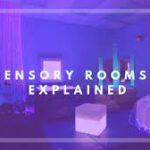Occupational therapists work with individuals to achieve lifetime skills across the lifespan. There are several transitions in OT services that must be planned for to ensure your child continues to receive necessary services including the transition from IFSP to IEP and the transition to young adulthood. An important transition for parents of infants and toddlers to learn about is the IFSP to IEP transition.
What is an IFSP?
You may be wondering what an IFSP is – IFSP stands for Individualized Family Services Plan. An IFSP is a document that describes the early intervention services and supports that your child is eligible to receive and lays out goals developed by all members of your child’s early intervention team (including you, the family!). The first three years of life is one of the most critical periods of development for a child since the brain displays the most plasticity (ability for neural networks within the brain to grow, change, and reorganize) during this period. Early intervention services can make a tremendous impact on your child’s developmental outcomes. Under the Individuals with Disabilities Education Act (IDEA) Part C, infants and toddlers with disabilities and their families are eligible for early intervention services. These services are partially funded by a federal grant that is divided among the states. Families whose children are referred for an early intervention evaluation are eligible to receive this evaluation as well as assessments, IFSP development, EI service coordination, and transition services for free or with insurance copayment. Early intervention services beyond those listed may be covered by health insurance (including Medicaid) or charged for on a sliding scale.
 How do I get an IFSP for my child?
How do I get an IFSP for my child?
Children who are diagnosed with a serious condition at birth can receive early intervention services immediately (in the hospital) and will be set up with early intervention services in the community upon discharge. Children ages birth to 3 years old who were not diagnosed at birth, but are showing signs of possible developmental delays will need an evaluation to determine if they are eligible for an IFSP. Medical providers, including your child’s pediatrician, may refer your child for an early intervention evaluation. This evaluation will assess your child’s skills in several areas including gross motor skills, fine motor skills, developmental milestones, sensory processing, language and communication skills, and any behavior concerns. After the evaluation, the family will meet with the early intervention team to discuss the results and determine whether your child will need early intervention services. If your child is eligible, the team (including the child’s family) will put together an IFSP outlining the planned services, supports, and goals.
What is an IEP?
An IEP or Individualized Education Plan is a plan developed by a team of professionals at your child’s local school district (and the parents/guardians of the child) which describes the special education services and supports that your child is eligible to receive and lays out goals developed by the members of the team. The IEP is typically reviewed and revised yearly.

How will we plan for my child’s transition from IFSP to IEP?
Planning for your child’s transition from an IFSP to and IEP may start as early as the first IFSP meeting and will continue to be planned at each IFSP review (generally once every 6 months). The IFSP to IEP plan will be documented on the transition plan page of your child’s IFSP. When your child is approaching their 3rd birthday (no fewer than 90 days and no more than 9 months before the birthday) you will meet with the IFSP team for a transition conference. At this conference, you will discuss transition options and decide whether your child will continue to receive early intervention services (until they age-out), transition to alternative community services, or transition to an IEP.

Can my child continue to receive Early Intervention Services after their 3rd birthday?
Yes! Connecticut’s policy regarding transitions from the early intervention system was recently revised (October, 2021) – now, eligible families have the choice to continue early intervention services in the EIS Over 3 option and receive early intervention services after their child’s 3rd birthday. Your child may continue to receive early intervention services under EIS Over 3 until they are covered under an IEP in preschool, or until they are performing at age-level in all areas of development.
How will my child receive an IEP?
Following the transition conference, the IFSP team can refer your child to the local school district. You may request (or you may receive a referral for) a Planning and Placement Team (PPT) for your child. You will attend a PPT meeting and the team will determine which evaluations your child will receive to determine whether they need an IEP. As a member of the PPT, parents or guardians may request specific evaluations for their child. Once your child’s IEP is written, you will continue meeting with the PPT yearly to review and revise your child’s IEP. Once every three years, a reevaluation of your child will be completed which may involve new assessments if necessary. This three-year reevaluation is called a “Triennial.”
What should I expect from my child’s transition into young adulthood?
Under the Individuals with Disabilities Education Act (IDEA) children with disabilities are entitled to a free public education, through the age of 22 (or until they complete high school), that meets their individual needs. The IDEA also mandates that children with disabilities must be offered transition services to assist with the adjustment from school to adult life. As a parent, you can expect transition planning for your child’s transition out of high school to begin as early as age 14 (or by 16 the latest). Some students’ transition plan will involve planning to graduate at age 18, while other students will choose to remain in school and continue utilizing transition services through age 22. This decision will be made with careful consideration during transition planning meetings that include the student, parents, and the rest of the PPT team. Transition services that your child may receive to help with the transition into young-adult life include vocational education, experiences in the community, assistance with planning for employment, assistance with development of independent living skills, and a vocational evaluation. Vocational programs in the community are offered to adolescents and young adults with disabilities who are transitioning out of high school. For example, Project SEARCH is a 1-year vocational program that has sites across the U.S. and internationally. The program helps individuals with disabilities who are making the transition from school into employment by offering job coaching, education on job-readiness skills, and assistance finding and succeeding at internships. Project SEARCH is only one of a number of vocational programs available to individuals with disabilities. Your child’s PPT team can connect your family with a vocational program that meets your child’s individual needs.







